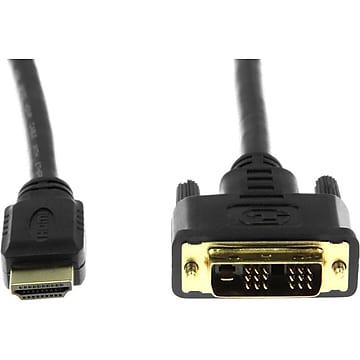DVI Cables
Related Searches
Whatever cable you need, Staples has you covered. Learn more about DVI monitor cables and how to use them below.
What Is a DVI Monitor Cable?
DVI stands for digital video interface. A DVI monitor cable is generally used with a desktop or laptop computer to connect a video source to a display device. There are a few variations of DVI cables: DVI-A, DVI-I and DVI-D. Whether your cable has a flat pin on one side will tell you whether it’s analog or digital. DVI-A and DVI-I cables are designed with a flat pin that has four pins around it. DVI-D cables just have one flat pin. DVI-D cables are typically used for digital connections, DVI-A is for analog, and DVI-D is versatile enough for both types of connections. DVI cables usually do not provide audio, so they’re not recommended for connecting to a TV.
How to Connect a DVI Cable to a Monitor
A new computer monitor may come with a DVI cable. If not, be sure to check your monitor’s compatibility before purchasing a computer monitor DVI cable. Plug the corresponding end of your cable into your monitor and the other end into the graphics card of your PC. If your graphics card is older and does not have a DVI socket, you may need to purchase an analogue-to-digital converter. If connecting to a laptop, you’ll need a mini-display-port-to-DVI adapter.
What Is the Maximum Resolution Available for DVI Monitor Cables?
The image resolution you’re able to achieve depends on whether you have a single link or a dual link cable. Single link DVI monitor cables support image resolutions up to 1920x1200 at 60 Hz. Dual link DVI cables have an increased bandwidth that can support a resolution up to 2560x1600 at 60 Hz.
Is DVI Better Than HDMI?
It’s visually easy to tell monitor DVI cables and HDMI cables apart. Being the more recent technology, HDMI cables are smaller and thinner in size. The plug is octagonal in shape with fewer pins than a DVI cable plug, which is rectangular in shape. HDMIs are more common today, but deciding on which is better for you largely depends on compatibility with your device. Both cable types have their limitations, but again, since HDMIs are the younger technology, they typically provide the best quality.
Today’s HDMI cables can support a maximum data rate of 42.6 Gbit/sec. With this rate, an HDMI cable can support great image resolution and refresh rate combinations: up to 4K at 144 Hz or an impressive 8K at 120 Hz using Display Stream Compression. DVI cables, on the other hand, have a maximum data rate of 9.9 Gbit/sec, so the maximum resolution and refresh rate you’ll get out of them is 3840x2400 at 30 Hz or 2560x1600 at 60 Hz.
HDMI cables can also transfer audio signals where DVI can’t. So if you’re using DVI cables and need to support audio, you’ll have to purchase audio cables. That said, DVI cables may be a good choice for games and those without audio needs, but HDMI would be preferred for connecting to a TV.

























































